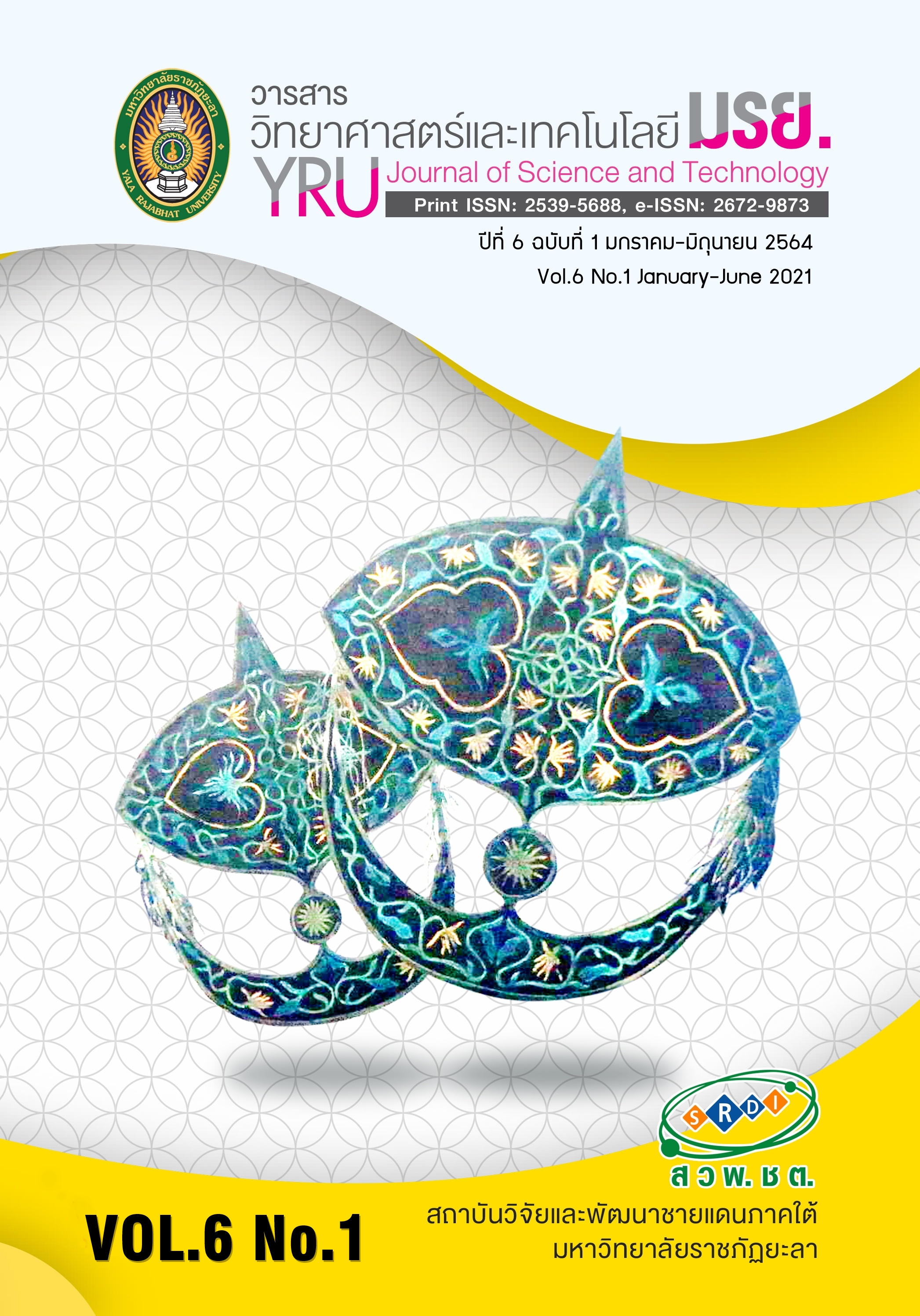การใช้น้ำทิ้งจากโรงงานอุตสาหกรรมผลิตปลาส้มเพื่อการผลิตแคโรทีนอยด์ โดยยีสต์ Rhodotorula mucilaginosa UP12
Main Article Content
บทคัดย่อ
การศึกษาสูตรอาหารโดยใช้น้ำทิ้งจากอุตสาหกรรมการผลิตปลาส้มเป็นองค์ประกอบ เพื่อใช้ผลิตสารแคโรทีนอยด์จากยีสต์ Rhodotorula mucilaginosa UP12 ที่แยกจากดินในเขต มหาวิทยาลัยพะเยา โดยทดลองเลี้ยงยีสต์ในสูตรอาหารปรับส่วนผสมทั้งหมด 6 สูตร ประกอบด้วยน้ำล้างปลา (C1) และน้ำล้างปลาที่เติมแหล่งคาร์บอน และไนโตรเจน (C2 C3 C4 C5 และ C6) เปรียบเทียบกับอาหารควบคุม yeast malt extract (YM) พบว่า อาหารสูตร C5 เหมาะสมสำหรับการผลิตแคโรทีนอยด์มีองค์ประกอบดังนี้ น้ำล้างปลาเติมน้ำตาลซูโครส 1% โดยมวลต่อปริมาตร และแอมโมเนียมซัลเฟต 0.2% โดยมวลต่อปริมาตร ปรับพีเอช 5 บ่มที่อุณหภูมิ 30 องศาเซลเซียส เขย่าที่ความเร็วรอบ 100 รอบต่อนาที ระยะเวลา 7 วัน สามารถผลิตแคโรทีนอยด์ได้สูงสุด ใกล้เคียงกับอาหารควบคุม โดยมีปริมาณแคโรทีนอยด์ 120.20±15.25 ไมโครกรัมต่อกรัมน้ำหนักแห้ง และปริมาณผลผลิตทั้งหมดเท่ากับ 0.47±0.02 มิลลิกรัมต่อลิตร จากการศึกษาในครั้งนี้พบว่าสูตรอาหาร C5 มีปริมาณผลผลิตแคโรทีนอยด์สูงกว่าอาหาร YM 1.2 เท่า ซึ่งเป็นไปได้ว่าสามารถใช้อาหารสูตร C5 เพื่อลดต้นทุนการผลิต แคโรทีนอยด์ในภาคอุตสาหกรรม อีกทั้งยังเป็นแนวทางในการประยุกต์ใช้น้ำทิ้งจากอุตสาหกรรมอื่น ๆ เพื่อการผลิตแคโรทีนอยด์ต่อลิตร
Article Details
บทความ ข้อมูล เนื้อหา รูปภาพ ฯลฯ ที่ได้รับการเผยแพร่ในวารสารวิทยาศาสตร์และเทคโนโลยี มรย. นี้ ถือเป็นลิขสิทธิ์ของวารสารวิทยาศาสตร์และเทคโนโลยี มรย. หากบุคคลหรือหน่วยงานใดต้องการนำทั้งหมดหรือส่วนหนึ่งส่วนใดไปเผยแพร่ต่อหรือกระทำการใดๆ จะต้องได้รับอนุญาตเป็นลายลักษณ์อักษรจากวารสารวิทยาศาสตร์และเทคโนโลยี มรย. ก่อนเท่านั้น
เอกสารอ้างอิง
Cardoso, L., Karp, S., Vendruscolo, F., Kanno, K., Zoz, L. & Carvalho, J. (2017). Biotechnological Production of Carotenoids and Their Applications in Food and Pharmaceutical Products. IntechOpen,125-141.
Tang, W., Wang, Y., Zhang. J., Cai, Y. & He, Z., (2019). Biosynthetic Pathway of Carotenoids in Rhodotorula and Strategies for Enhanced their Production. Journal of Microbiol Biotechnol, 29(4), 507-517.
Kot, AM., Blazejak, S., Kurcz, A., Gientka, I. & Kieliszek, M. (2016). Rhodotorula glutinis-Potential Source of Lipid, Carotenoids and Enzyme for Use in Industries. Applied Microbiology and Biotechnology, 100, 6013-6117.
Andrade, RSF., Lima, RA., Ribeaux, DR., Araújo, HWC., Franco, LO., Pessoa-Júnior, A., et al. (2016). Production of β-Carotene by a Newly Isolated Rhodotorula Glutinis UCP1555 Strain and Cytotoxic Effect Evaluation. Journal of Chemistry and Chemical Engineering, 10, 212-220.
Tábita Veiga Dias Rodrigues , Thalita D. Amore , Erika Carvalho Teixeira and Janaina Fernandes de Medeiros Burker (2019) Carotenoid Production by Rhodotorula mucilaginosa in Batch and Fed-Batch Fermentation Using Agroindustrial Byproducts. Food technology and Biotechnology, 57(3), 388-398
Cheng, Y. & Yang, C. (2016). Using Strain Rhodotorula mucilaginosa to Produce Carotenoids Using Food wastes. Journal of the Taiwan Institute of Chemical Engineers, 61, 270-275.
Meksagul, K. & Suwannapat, P. (2013). Impact study for Environmental Management standard of ISO 14000 to Implementation in Sonviang Mai Preserved Fish Factory (Sriton Preserved Fish) Phayao. The 31st IE Network Conference, October 16-18, 2013. Pattaya, Chonburi.(in Thai)
Passorn, S., Sookwanna, N. & Auputinan, P. (2016). Screening of Carotenogenic Yeasts from Natural Soil at the University of Phayao. Burapha Science Journal, 21(3), 15-22. (in Thai)
APHA, AWWA & WPCF. (2005). Standard Methods for the Examination of Water and Wastewater (23th ed.). Washington D.C.: American Public Health Association.
Dubois, M., Gilles, K.A., Hamilton, JK., Rebers, PA. & Smith, F. (1956). Calorimetric Method for Determination of Sugars and Related Substances. Analytical Chemistry, 28, 350 -356.
Tansin, K. (2010). Enhancement of Carotenoid Production by Phaffia rhodozyma and it’s Stability. Thesis. Master of Science, Silpakorn University, Thailand. (in Thai)
Elsanhoty, RM., Al-Turki, AI. & Abd El- Razik, MM. (2017). Production of Carotenoids from Rhodotorula mucilaginosa and their Application as Colorant agent In Sweet Candy. Journal of Food, Agriculture & Environment, 14(2), 21-26.
Aksu, Z. & Eren, A. (2005). Carotenoids Production by the Yeast Rhodotorula mucilaginosa: Use of Agricultural Wastes as a Carbon Source. Process Biochemistry, 40(9), 2985-2991.
Maldonade. IR., Scamparini, ARP. & Rodriguez-Amaya, DB. (2007). Selection and Characterization of Carotenoid-Producing Yeasts from Campinas region, Brazil. Brazillian. Journal of Microbiology, 38, 65-70.
Dhaliwal, MK. & Chandra, N. (2015). Optimization of Carotenoids Production by Rhodotorula mucilaginosa. International Journal of Pharmaceutical Sciences and Research, 6(3), 1161-1165.
Wang, Q., Liu, D., Yang, Q. & Wang, P. (2017). Enhancing Carotenoid Production in Rhodotorula mucilaginosa KC8 by Combining Mutation and Metabolic Engineering. Annals Of Microbiology, 67(6), 425-431.
Pena, A, Helber, N.S.S, Alvarez, Calahorra M. and Ramirez J. (2015). Effects of high medium pH on growth, metabolism and transport in Saccharomyces cerevisiae. Federation of European Microbiology Societies, 20(2),
-13.


